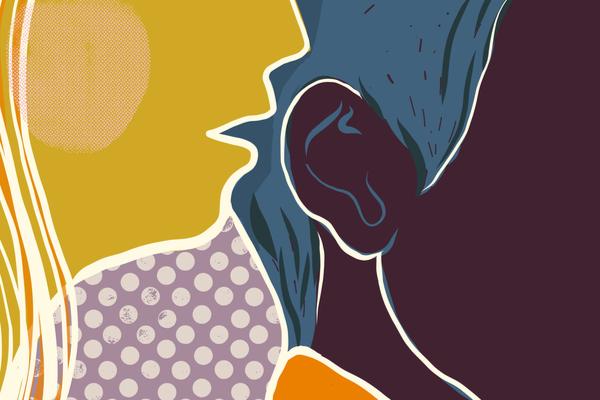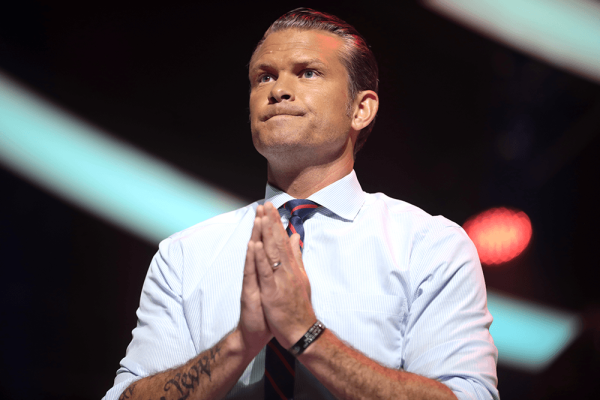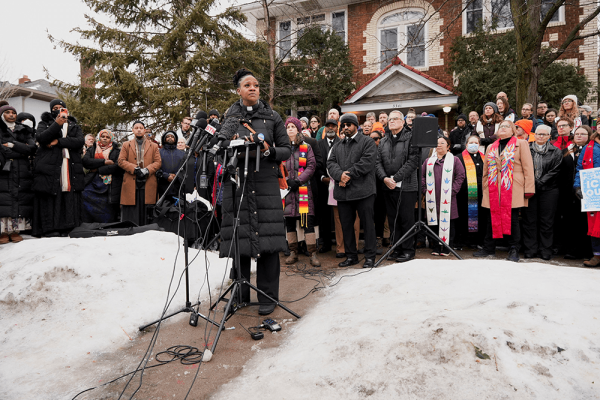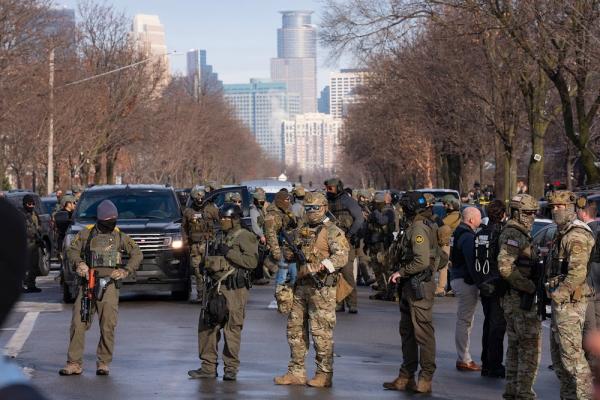Chris has attended the same local church for five years. When services went remote due to the coronavirus pandemic, Chris and his partner noticed paid staff of the church sharing misinformation about hydroxychloroquine on social media. Chris hoped that the church leadership, including the pastor, would push back. Instead, the pastor, through the spring and into the summer, used his platform to condemn “cultural Marxism” and equate Black Lives Matter protesters rioting with the death of George Floyd.
Chris and his partner — who asked to remain anonymous because he is still affiliated with the church — have distanced themselves from the congregation. “When we don't use those opportunities to cultivate those relationships with our families, with our neighbors, with our friends, that's the time when the skepticism and the conspiracy theories start to creep in. We start to see them as the enemy,” said Chris. “I think a lot of that disconnect, in the isolation, and the fact that we're behind our phones, really is being highlighted by this kind of dual season that we're in, of both this pandemic and the 2020 election.”
And he’s right: The shadow of “fake news” is unavoidable in the 2020 election. Disinformation — from online forums like Reddit and 4chan or misleading websites impersonating legitimate news sources — populates Facebook or Twitter newsfeeds. The New York Times recently uncovered a network of 1,300 online “local news” sites that are spreading propaganda paid for by conservative political operatives. At a White House press briefing in September, press secretary Kayleigh McEnany repeated a fake story about absentee ballots discovered in a ditch in Wisconsin. Later that same month, Rep. Ilhan Omar (D-Minn.) was falsely accused of election fraud by the conservative group Project Veritas in what researchers at Stanford and the University of Washington called a “coordinated disinformation campaign.” In October, right-wing activists were charged with coordinating a robocall campaign to discourage “minority voters” from voting.
Jesse Littlewood, who runs the Stopping Cyber Suppression program at the nonpartisan voting rights group Common Cause, told NPR that the group has identified nearly 5,000 incidents of disinformation so far this year.
Religious communities are being impacted — and in some cases, targeted — by rampant disinformation. While some religious groups, like Chris’s, may be spreading it, others are attempting to figure out their role in combating it.
The lure of disinformation
Though claims of “fake news,” or falsified news stories presented as truth, have dominated political discourse in the past four years, these claims are just one part of the wider construct of disinformation, which Merriam-Webster defines as “false information deliberately and often covertly spread in order to influence public opinion or obscure the truth.” Claire Wardle of First Draft News, a project focused on combating disinformation, breaks disinformation into seven recurring forms: satire or parody; false connection (where headlines or visuals don’t match the content itself); misleading content; fake content designed to impersonate real content; fabricated content; and real information that has been manipulated or presented in a false context. In practice, that could range from deepfakes (videos in which someone’s face is digitally plastered onto another’s body) to WhatsApp chains spreading conspiracy theories.
This has had an obvious impact on national belief in our electoral system. A recent survey from the Public Religion Research Institute found that 57 percent of Americans ranked the fairness of the presidential elections as the most critical issue facing the country; similarly, in early October, a Gallup poll found that belief in the legitimacy of our elections is at a record low, with over 40 percent of Americans lacking confidence.
Part of this skepticism stems from the distrust that President Donald Trump and other elected officials have sown, including the repeated discrediting of mail-in ballots and encouraging right-wing vigilantes like the Proud Boys to “stand by” and monitor the polls. Such behavior has increased fears of violence at the polls or during a transition of power if Trump loses. This skepticism is also legitimately based on what we saw happen during the previous presidential election, when suspicion of the Trump campaign’s digital tactics launched investigations into Russian interference in the election. Fear of Russian interference hasn’t been forgotten, but in 2020, the call is coming from inside the house.
The rise of election-related disinformation also arrives at a time where conspiracy theories, like QAnon, are increasingly prolific online — especially in some evangelical communities. QAnon, which started online in 2017 and casts the president as a renegade fighter on behalf of sex-trafficked children, targets Christian conservatives through social media, leading to a rash of support spreading among evangelicals. Between March 2020 and July 2020, QAnon-related content saw a 650 percent increase in popularity on Facebook. A fringe evangelical sect has even begun Bible studies focused on the perceived messages of QAnon’s anonymous leader.
As John Cook, scholar on disinformation at George Mason University, told the Washington Post this May, people turn to conspiracy theories in times of crisis to create a sense of order. According to University of Victoria professor Christopher Douglas, American-grown and -targeted disinformation tends to be more salient on the Right than the Left, and typically involves a religious component. The biggest fake news headlines of 2016 and 2017 included Satan-worshipping Democrats, Hillary Clinton supporting ISIS, or the pope endorsing Trump — and Christians are often its target. A recent study by MIT Technology Review found that Hispanics, and Catholic Hispanics in particular, were targeted with disinformation surrounding the nomination of Judge Amy Coney Barrett to the Supreme Court.
Experts caution that our current moment of disinformation is hardly new, and actually feeds off of recent decades’ conservative religious tactics. Religious studies scholar Megan Goodwin, in an interview with Religion Dispatches, traces that lineage from the emergence of the “New Christian Right” and its allegiance between conservative evangelicals and conservative Catholics in the 1970s, to the “Satanic Panic” of the 1980s. Douglas ties the efficacy of right-wing disinformation among religious voters to a legacy of evangelical skepticism of “outsider” experts.
Fake news and disinformation does exist on the Left, though typically it’s seeking to indulge in liberal mocking of Trump, rather than on values-based issues. This election cycle has seen some disinformation targeting the Left: In 2019, a website purporting to be run by Joe Biden’s campaign, highlighting Biden’s less-appealing qualities for those on the Left, was created by a Trump campaign consultant.
In a recent panel hosted by UCLA’s Hammer Museum, experts stressed that the real purpose of disinformation is not necessarily to serve a particular candidate; it’s to make you unsure, confused, and ultimately, less likely to vote.
How to combat disinformation
When it comes to phenomena like QAnon, there can be a tendency from the Left and by media outlets alike to treat it like a crazy trend instead of a serious issue. These “trends” have impact: Republican voters have mainstreamed QAnon, the president has retweeted QAnon content, and the FBI in 2019 named conspiracy theories like QAnon a domestic terror threat.
Social media platforms like YouTube, Facebook, and TikTok have recently taken strides to ban QAnon-related content and other disinformation campaigns. But some religious leaders are still struggling to combat the rampant disinformation, especially given how communities have been impacted by stay-at-home orders. “Without [in person] gatherings, some [churchgoers] had turned instead to Facebook, podcasts, and viral memes for guidance,” reported Abby Ohlheiser. “And QAnon, a movement with its own equivalents of scripture, prophecies, and clergy, was there waiting for them.”
Christian community leaders, including the Episcopal Church, Southern Baptist newspaper the Biblical Recorder, and the Gospel Coalition have made public statements condemning fake news, disinformation, and conspiracy theories, and attempting to correct the effects of disinformation.
The Episcopal Church’s guide to navigating disinformation suggests three key steps: Look at the source, ask what’s missing from the narrative, and watch for any strongly emotional response — it may be intentional manipulation. Tech outlet The Verge has a longer guide on fighting online disinformation. It recommends double-checking the details of the story, such as the publication date; we’ve all shared a story thinking it was breaking news, when really it’s from years ago.
Unfortunately, there’s no quick and easy solution to disinformation campaigns. Combatting propaganda requires a measured and researched approach that is hard to prioritize in our moment-to-moment news cycle. The best way to stop disinformation is to pause before jumping to conclusions. Ask yourself: Do you need to share this? Why do you want to? What’s the source?
And when in doubt, you can turn to sites like First Draft to fact-check stories.
Got something to say about what you're reading? We value your feedback!






